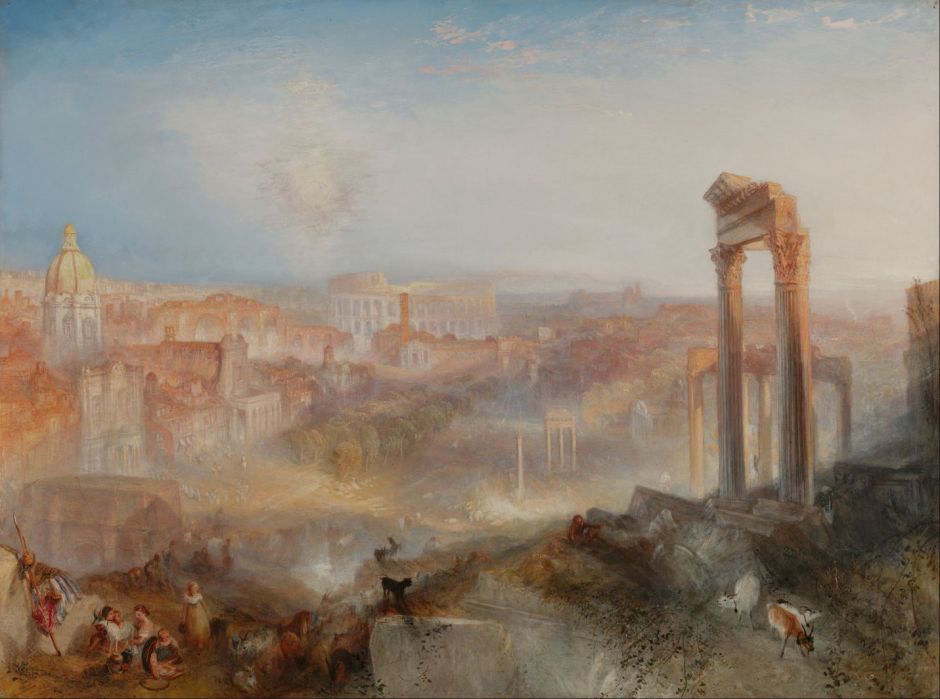Two years after Pompeii and Herculaneum had been destroyed by the eruption of Mount Vesuvius, the emperor Titus died of natural causes, at the age of just 41. His successor Domitian wasn’t as fortunate: when he wasn’t quite 45 he was assassinated following a conspiracy in the palace. He was the last Emperor of Rome to die violently for almost a century, though, as Rome and its far-flung empire finally seem to have resolved its internal strains.
From Titus onwards, with some exceptions, the painted history of Rome appears mainly in landscapes and views of its buildings.

When the Austrian painter Tina Blau visited Italy in the late 1870s, she painted this delightfully loose plein air Roman Capriccio with the Arch of Titus (1879).

Her View of the Arch of Titus Vespasian and Surrounding Ruins in the Roman Forum from the same year is larger and more finished.
The persecution of Christians continued unabated, and is commemorated in more paintings than any other aspect of Rome during this period.
Hieronymus Bosch’s painting of the patron saint of Sint-Janskerk in his home town of ‘s-Hertogenbosch makes the assumption that John, author of the Book of Revelation and the Gospel of John, is the same person as John the Apostle, the son of Zebedee.
It appears that John, practising and preaching as a Christian during the rule of Domitian, was banished to Patmos as a result. While he was there, he wrote the book of Revelation, addressed partly as a letter to the “seven churches of Asia”. Much of the rest of the book consists of a series of prophetic visions, featuring well-known figures such as the Whore of Babylon and the Beast (of 666 fame). It culminates in his description of the Second Coming of Jesus.

Bosch shows Saint John seated, writing, in the midst of a deep and extensive landscape, with an angel on a nearby hillock, and looking up to a vision of the Virgin Mary and Child.

Nicolas Poussin’s Landscape with Saint John on Patmos from 1640 shows another idealised landscape, probably based on the western Italian coast, rather than Patmos in the Dodecanese, in the eastern Aegean.
One of the most familiar landmarks in modern Rome is Trajan’s Column, erected in its own forum in 113 CE to commemorate the victory of the emperor Trajan in the Dacian Wars, fought on his behalf in the region of what is now Romania. Documenting the relief on this column was one of Piranesi’s last major projects in 1774.

His View of the Main Face of Trajan’s Column. is just one of many meticulous etchings he made of the historical scenes which wind their way up the column.

A few years later, Piranesi made this chalk study of The Octagonal Room in the Small Baths at the Villa of Hadrian (Tivoli) (c 1777).
This was the period in which another prominent landmark in the city was built: construction of the Colosseum began in 72 CE under Vespasian, was completed in 80 when Titus was emperor, and was modified substantially during the reign of Domitian. It was the largest amphitheatre built in Classical times.

During the nineteenth century, several artists including most notably Jean-Léon Gérôme, attempted to reconstruct scenes and events in locations like the Colosseum. One of the earliest of these spectacular reconstructed views came in 1836, in Alexey Tarasovich Markov’s Eustace Placido in the Colosseum, showing the martyrdom of Saint Eustace, although other traditions claim that he and his family were roasted to death inside a bronze statue of a bull, on the command of the emperor Hadrian in 118 CE.
My favourite painting of these later years of the Roman Empire shows an atypical tragi-comic assassination.

Known best for his Naturalist depictions of street-urchins and other destitutes, Fernand Pelez’s first works were history paintings, including The Death of the Emperor Commodus, from 1879. Commodus, who reigned from 180-192 CE, was a larger than life character, aspired (foolishly) to be a gladiator, and a megalomaniac. He was assassinated by being strangled in his bath, after an earlier attempt to poison him had failed. He was so hated that after his death the Senate declared him a public enemy.
Pelez shows the professional wrestler who was paid to murder the emperor bent over the corpse just after the act. Behind them is the bath in which Commodus had been, and the killer is talking to a woman, presumably a courtesan, who looks very surprised despite her extensive veil.
Much of the official killing remained that of Christians, who continued to be fair game until the Emperor Constantine’s conversion in 312 CE.

Paul Delaroche’s moving painting of The Young Martyr (1853) shows a young Christian woman whose hands were bound before she was thrown into the River Tiber in Rome, during the reign of Diocletian (284-305 CE). The writer and critic Théophile Gautier considered her a “Christian Ophelia”, and a paragon of divine beauty.
With the decline of the Roman Empire leading to the Sack of Rome in 410 CE, and the arrival of the Middle Ages, Rome and its history faded from paintings. The great days were past, and sheep were grazing in its ruins.


